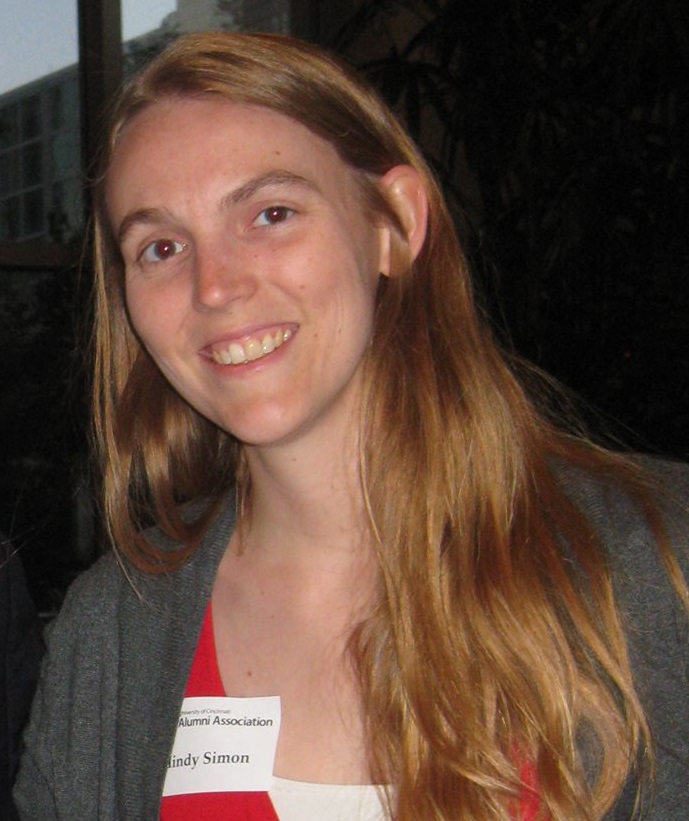Simon, Melinda

Assistant Professor
Preferred: melinda.simon@sjsu.edu
Telephone
Preferred: (408) 924-3956
Office Hours
By arrangement
Office
E233M
San José State University,
One Washington Square,
San José, CA 95192-0085.
Education
- B.S. (Chemical Engineering, University of Cincinnati, OH)
- M.S. (Biomedical Engineering, University of California, Davis)
- Ph.D. (Biomedical Engineering, University of California, Irvine)
Bio
Academic Appointments
- Assistant Professor of Biomedical Engineering (San José State University)
- Post-doctoral Scholar (Materials Engineering Division, Lawrence Livermore National Laboratory, Livermore, CA)
- Post-doctoral Scholar (Surgery Department, Stanford University School of Medicine, Stanford, CA)
Honors and Awards
- California Institute of Regenerative Medicine Predoctoral Fellow, 2013-2014
- ARCS Foundation Scholar, Orange County chapter, 2012-2014
- NSF-IGERT LifeChips Fellow, UC Irvine, 2009-2012
Classes Taught
- BME 117 Biotransport Phenomena
- BME 168 Medical and Biological Polymers
- BME 177 Physiology for Engineers
- BME 207 Experimental Methods in Biomedical Engineering
- BME 254 Microscale Biomedical Systems
- BME 291 MS Project/Thesis Preparation Seminar
Research and Scholarly Interests
- Microfluidics for single cell analysis
- Development of new bioink materials for bioprinting
Current Research
- Multi-step assays in droplets
Picoliter and nanoliter droplets, produced using microfluidics have been used to great advantage in conducting biological assays in a miniaturized format. Compartmentalization using droplets enables the study of individual cells one by one (single cell analysis), and concentrates the signal in fluorescence-based detection schemes, providing an advantage in lowering the limit of detection. A major limitation of this technology is the difficulty encountered in conducting assays involving multiple steps since reagent addition and complete solution exchange can be quite difficult. We are working to develop technology to enable the addition and removal of materials from droplets, enabling assays involving multiple steps to be performed, and vastly expanding the applications of droplet microfluidics.
- Development of new bioink materials
The subset of materials available for bioprinting inks is limited by requirements that the material be shear-thinning and printable, but also capable of forming to a semisolid structure once printed. Ink material selection is further limited by temperature and other constraints imposed by working with live cells. In our group, we are working to broaden the range of materials that can be used to print with living cells, which will ultimately provide better tissue, organ, and system models that more closely mimic the physiology.
Selected Publications
-
Moya, M. L., Triplett, M., Simon, M., Alvarado, J., Booth, R., Osburn, J., Soscia, D., Qian, F., Fischer, N.O., Kulp, K. and E. Wheeler. (2019) Validation of a reconfigurable in vitro neurovascular model for studying the complexity of the blood brain barrier. Annals of Biomedical Engineering, 1-14. doi:10.1007/s10439-019-02405-y
- Nimbalkar, P., Tabada, P., Bokare, A., Chung, J., Mousavi, M., Simon, M., & Erogbogbo, F. (2019). Improving the physiological relevance of drug testing for drug-loaded nanoparticles using 3D tumor cell cultures. MRS Communications, 1-7. doi:10.1557/mrc.2019.91
- Luo, J.*, Simon, M.G.*, Jiang, A. Y. L., Nelson, E.L., Lee, A.P., Li, G.P., and M. Bachman. (2016) 3-D In-Bi-Sn Electrodes for Lab-on-PCB Cell Sorting. IEEE Trans Components, Packaging, Manufacturing Tech, 6 (9) 1295-1300. doi: 10.1109/TCPMT.2016.2573161
- Simon, M.G., Li, Y., Arulmoli, J., McDonnell, L., Akil, A. Nourse, J.L., Lee, A.P, and L.A. Flanagan. (2014) Increasing Label-Free Stem Cell Sorting Capacity to Reach Transplantation-Scale Throughput. Biomicrofluidics, 8 (6) 064106. doi: 10.1063/1.4902371
- Patel, M., Nanayakkara, I., Simon, M.G., and Lee, A.P. (2014) Cavity-Induced Microstreaming for Simultaneous On-Chip Pumping and Size-Based Separation of Cells and Particles. Lab on a Chip, 14 (19), 3860-3872. doi: 10.1039/c4lc00447g
- Winkler, M.*, Simon, M.G.*, Vu, T., Gartner, T., Lee, A.P., Brown, D.J., and J.V. Jester. (2014) A Microfabricated, Optically-Accessible Device to Study the Effects of Mechanical Cues on Collagen Fiber Organization, Biomedical Microdevices, 16 (2) 255-67. doi: 10.1007/s10544-013-9829-x
- Lin, R., Fisher, J., Simon, M.G., and Lee, A.P. (2012) Novel On-Demand Droplet Generation for Selective Fluid Sample Extraction. Biomicrofluidics, 6 (2) 024103. doi: 10.1063/1.3699972
- Simon, M.G.*, Lin, R*, Fisher, J.F. and Lee, A.P. (2012) A Laplace pressure based microfluidic trap for passive droplet trapping and controlled release. Biomicrofluidics, 6 (1) 014110. doi: 10.1063/1.3687400
Professional Service
- Assistant to the Editor, Lab on a Chip, 2011-2014
- Reviewer
Lab on a Chip, Nature Protocols, Journal of the American Chemical Society, Analyst, Integrative Biology, Biomedical Microdevices - Graduate Studies Admissions Committee, Biomedical Engineering Department, University of California, Irvine
Students
Current M.S. students
1. Lawrence Lu
2. Steve Titus
3. Shayan Moraveji
4. Jeremy Mallard
5. Brendan Heap
6. Adwitiya Bag
Current B.S. students
1. Aparna Bhandaru
2. Estelle Jordan
MS Alumni
- Linh Tran
- Priya Nimbalkar
- Ashley Hall
- Hawi Gemeda
- Shireen Narappanawar
- Cynera Dodati
- Ahsan Riaz
- Anh Thu Le
- Katelyn Christensen
- Nam Than
- Golsa Seyedeh Ghetmiri
- Ricky Dhanota
- Maunika Gosike
- Marzieh Mousavi
- Erika Young
- Songtao Ye